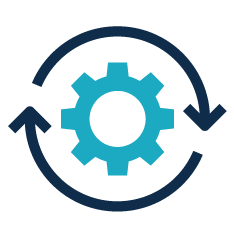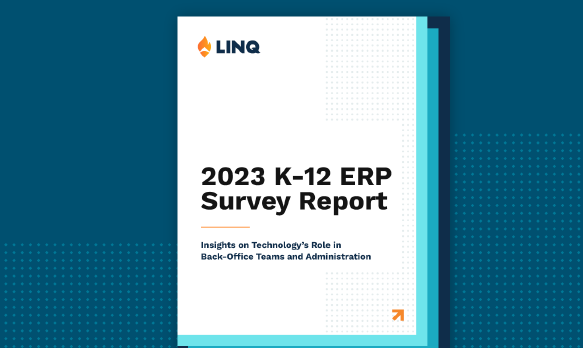Technology keeps transforming K‑12 operations. From improved communications and simpler workflows to deeper data analytics and real-time information, the right tools help everyone succeed. The pace of technological change in education increased exponentially in recent years, and it’s not an isolated phenomenon. The internet, social media, and most recently, artificial intelligence have disrupted entire industries and created new ones. Education continues to rapidly evolve along with the rest of our world.
However, not every K‑12 business professional experienced the same advances in their own district. Although back-office teams have never had access to a broader selection of technologies before, and ESSER funding made it possible for many districts to budget for generational improvements, operations didn’t get as much attention as student learning everywhere.
K‑12 Business and Administration Technology Priorities and Challenges
K‑12 business professionals nationwide often tell us outdated back-office systems cost their districts more than time and money—they cost them staff and, ultimately, negatively impact student success.
Where’s the disconnect?
LINQ partnered with EDGE Research to do a deep dive into:
- K‑12 business professionals’ use of technology
- Key priorities and areas of focus for investment
- How K‑12 business technologies work together
- Proven best practices for results today and into the future
The Findings Reveal Five K‑12 Business Technology Takeaways
 Takeaway #1: If you’re focused on hiring, you’re not alone.
Takeaway #1: If you’re focused on hiring, you’re not alone.
68% say hiring and retaining staff is their top business operations priority.
Consistent with widely reported staffing shortages over the last several years1, hiring and retaining staff was the top reported priority across the business office, regardless of role or team size.
Technology can support improvements in this area, simplifying processes and providing better support for hiring and retention efforts. Recruiting and hiring efficiency is one side of this challenge. The other is creating a great new-hire employee experience. Automating the onboarding process offers an effective place to start. In our survey findings, eight in 10 respondents identified keeping up with technology as critical, and 47% reported that lack of staff hurts the performance of their back office.
 Takeaway #2: Automation helps K‑12 districts save time and money.
Takeaway #2: Automation helps K‑12 districts save time and money.
79% whose back-office processes are automated feel prepared for the future.
While only 14% of respondents report that their back-office systems must support automation, those who already experience it say it’s instrumental in future-readiness. For the rest, two in 10 say something as simple as requesting time off means calling in manually, emailing, or informing their school in person.
The time it takes to complete mundane tasks can seem small, but it adds up. Research shows:
- “Work about work” remains a persistent threat, with roughly 23 hours of the 40-hour workweek lost to menial, repetitive tasks.2
- Over one year, 257 hours could be saved with an improved process.3
- Teams spend 13% of their time on work already completed—236 hours per year, or up to 30 days.4
- 69% of workers spend up to an hour per day navigating between apps—up to 32 days per year.5
 Takeaway #3: It’s not just technology; it’s how it’s integrated.
Takeaway #3: It’s not just technology; it’s how it’s integrated.
68% identify better technology integration as critical for improving accuracy and efficiency.
If you’re looking to save time, integration is as important as automation. The average number of applications reportedly used by K‑12 business professionals in the back office was 3.27. When asked if those applications were integrated with one another or with other departments, most indicate room for progress.

Many of the individual technologies reviewed in this research deliver value for their users and stakeholders. However, integrating technologies makes a good thing even better. Integrated software helps K‑12 business professionals operate more efficiently, improving collaboration, enhancing customer experience, supporting data-driven decision-making, and fostering innovation.
 Takeaway #4: Many districts are thinking beyond ESSER.
Takeaway #4: Many districts are thinking beyond ESSER.
35% worry about losing technology investment after ESSER funding ends.
Although 24% of respondents prioritize managing the impact of ESSER spending, an EdWeek survey6 suggests that more than half of K‑12 anticipates that the absence of ESSER funds will lead to a reduction in spending. Over one-third of respondents are also concerned about cuts due to per-pupil funding.
Overall, district K‑12 business professionals feel they are doing a good job preparing for upcoming Changes in ESSER Funding, with 59% of respondents giving themselves an Excellent or Very Good rating. However, only 24% rated ESSER fund management as a priority for their district. We anticipate this number to increase as the ESSER deadline of September 2024 approaches.
 Takeaway #5: Smarter decisions come from better data.
Takeaway #5: Smarter decisions come from better data.
72% see technology transforming K‑12 business processes for the better.
Data and analytics present some of the most promising opportunities for technology investment.
Real-time data insights let teams collect, analyze, and interpret the most up-to-date information whenever they need it. Long a priority for commercial businesses, in the context of other challenges facing K‑12 business professionals, analytics and business intelligence ranked comparatively low in priority in the survey:
- Only 11% of respondents report that data analytics/business intelligence is a top priority
- Only 13% of K‑12 business professionals plan to increase spending on analytics and business intelligence solutions
When prioritized at the leadership level, implementing a data-driven culture can significantly impact a district’s ability to proactively manage their performance, pivot when circumstances change, and prepare itself for future success. While improving operational efficiency and staffing bring immediate benefits, shifting to a longer-term view of improving analytics can give districts the power to realize continued improvement for years to come.
Get More K‑12 Business and Operational Statistics and Insights

Get your copy of our full K‑12 ERP Survey Report now for even more statistics, insights, and ideas for solutions. Get the freshest look at K‑12 business operations today and a glimpse of the future.
- 1 https://www.edweek.org/leadership/what-school-staffing-shortages-look-like-now/2022/09
- 2 https://resources.asana.com/rs/784-XZD-582/images/PDF-FY23-GLOBAL-EN-AOW23-GLOBAL-Anatomy-of-Work-Report.pdf
- 3 https://resources.asana.com/rs/784-XZD-582/images/PDF-FY23-GLOBAL-EN-AOW23-GLOBAL-Anatomy-of-Work-Report.pdf
- 4 https://kanboapp.com/what-you-need-to-know-about-work-about-work/
- 5 https://kanboapp.com/what-you-need-to-know-about-work-about-work
- 6 Bakely, M. (2022, November 2-3) “Welcome and Summit Kickoff: The State of the K‑12 Business”. [Presentation]. EdWeek Market Brief Summit, Dallas, TX.
